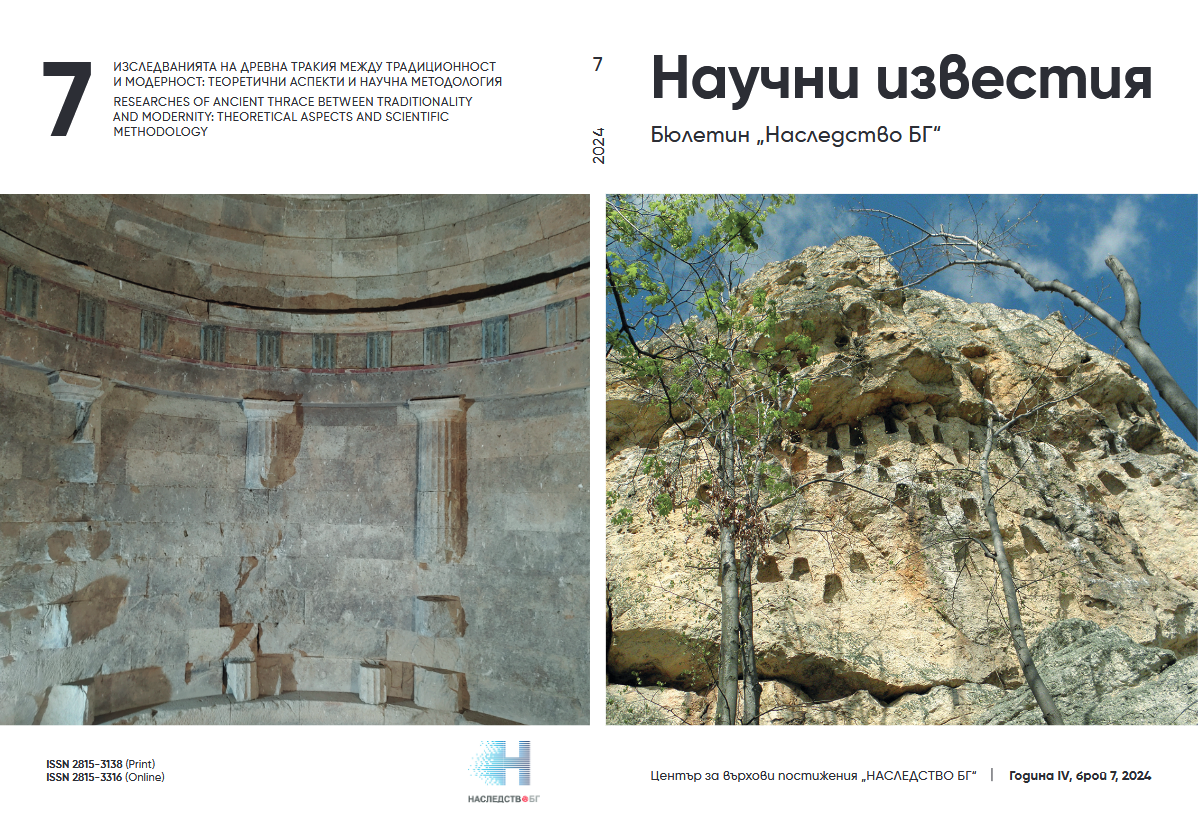Разкриване на стратегии за визуална комуникация в зони на културно взаимодействие
възможности предизвикателства дигиталната епоха
Ключови думи :
антична скулптура, управление на данни, визуализация, пространствен анализ, достъпни етични изследванияАбстракт
Скулптурните произведения са сложни единици, състоящи се от множество елементи, които могат да предават широк спектър от значения. Иконографските характеристики, изборът на материали, техники, стилове и комбинации с други комуникативни елементи като надписи и дипинти допринасят за многостранния характер на тези произведения. Тъй като те са циркулирали в обширни мрежи извън определени региони и политически системи, те също така служели като медии на транскултурно взаимодействие. За да се справим с тази висока плътност на информация, е необходимо да се прилагат организационни системи, които могат да организират и анализират голямо количество данни с високо ниво на детайлност. В предварително изследване, което се фокусира върху драпирани куроси, използването на географски визуализации се оказа особено ефективно за изясняване на сложните взаимовръзки между скулптурите, покровителите и потребителите, свързани тях, както в рамките на, така и извън регионалните граници. Резултатите от такива анализи могат да осигурят стабилна основа за по-нататъшни проучвания, например по отношение организaцията на работилниците и използването на материали. Използването на установени нормативни речници и тезауруси, и осигуряването на достъп до данните чрез отворени хранилища гарантира, че те са лесно достъпни за по-нататъшни изследвания. Въпреки че е изключително ценно за анализа на специфични скулптурни групи, справянето с по-голяма сложност и по-голямо разнообразие от типове обекти и категории в обектно-базирани релационни бази данни, като същевременно поддържа последователна и ясна организация, може да създаде трудности. Те ще бъдат оценени на следващия етап от проекта.
Библиография:
Anevlavi, V., Ladstätter, S., & Prochaska, W. (2021). Meter reliefs from Ephesos and the Obizzi Collection (KHM Wien). Archaeometric Considerations on the Production and Trade of Small-Format Marble Objects in the Greek World. - Journal of Archaeological Science: Reports, No. 47, 103742. https://doi.org/10.1016/j.jasrep.2022.103742 (accessed 28.06.2024).
Barletta, B. (1987). The Draped Kouros Type and the Workshop of the Syracuse Youth. – American Journal of Archaeology, No. 91, 233-246.
Bernal, M. (2001). Black Athena Writes Back. Martin Bernal Responds to His Critics. Durham.
Bernal, M. (2020). Black Athena. The Afroasiatic Roots of Classical Civilization. London.
Bosnakis, D. (2012). Ενεπίγραφος ενδεδυμένος κούρος από την Κάλυμνο. In: Neue Funde archaischer Plastik aus griechischen Heiligtümern und Nekropolen / Athenaia 3 (eds. Georgia Kokkorou-Alevras, Wolf-Dietrich Niemeier). Athens, 157-187.
Bree, P. van, Kessels, G. (2013). Nodegoat: A Web-Based Data Management, Network Analysis & Visualisation Environment, http://nodegoat.net from LAB1100, http://lab1100.com (accessed 28.06.2024).
Counts, D., Averett, E., Garstki, K. (2016). A Fragmented Past: (Re) Constructing Antiquity Through 3D Artefact Modelling and Customised Structured Light Scanning at Athienou-Malloura, Cyprus. - Antiquity, No. 90/349, 206-218.
Floren, J. (1987). Die griechische Plastik 1: Die geometrische und archaische Plastik / Handbuch der Archäologie. Munich.
Hodos, T. (2020). The Archaeology of the Mediterranean Iron Age. A Globalising World c. 1100–600 BCE. Cambridge.
Hoff, R. von den. (2022). Im Netz von Form und Zeit. 100 Jahre Ernst Langloto’ Zeitbestimmung und ihre Chronologiemethodik. In: Scherben und Geschichte. Die absolute Datierung bemalter griechischer Keramik / CVA Beiheft 10 (ed. Stefan Schmidt). München, 29-44.
Iacovou, M. (2021). Cyprus in the Context of Phoenician Studies. The Homeland Evidence. In: LRBT. Dall’archeologia all’epigrafia. Studi in onore di Maria Giulia Amadasi Guzzo / Semitica & Classica Suppl. 3 (eds. Nicola Chiarenza, Bruno D’Andrea, Adriano Orsingher). Turnhout, 291-312.
Kansteiner, S., Hallof, K., Lehmann, L., Seidensticker, B., & Stemmer, K. (eds.). (2014). Der Neue Overbeck. Die antiken Schriftquellen zu den bildenden Künsten der Griechen. Berlin, New York.
Kühnl, A. (2020). Iconclass: Ein Klassifizierungssystem für Kunst – und Mensch? – The ARTicle. https://doi.org/10.58079/ (accessed 28.06.2024).
Langlotz, E. (1975). Studien zur nordostgriechischen Kunst. Mainz.
Morris, S. (1992). Daidalos and the Origins of Greek Art. Princeton.
Özgan, R. (1978). Untersuchungen zur Archaischen Plastik Ioniens. PhD Dissertation, Rheinische Friedrich-Wilhelms-University, Bonn.
Patay-Horváth, A. (2016a). Master-Hand Attributions of Classical Greek Sculptors by 3D-Analysis at Olympia - Some Preliminary Remarks. In: Keep the Revolution Going: Proceedings of the 43rd Annual Conference on ComputerApplications and Quantitative Methods in Archaeology CAA 2015 (eds. Stefano Campana, Roberto Scopigno, Gabriella Carpentiero). Oxford, 329-336.
Patay-Horvath, A. (2016b). Der Zeustempel von Olympia. Rekonstruktionen des Tempels und des Ostgiebels im Vergleich. In: 3D-Anwendungen in der Archäol-ogie. Computeranwendungen und quantitative Methoden in der Archäologie – Workshop der AG CAA und des Exzellenzclusters topoi 2013 (eds. Undine Lieberwirth, Irmela Herzog). Berlin, 77-91.
Prochaska, W., Attanasio, D. (2021). The Challenge of a Successful Discrimination of Ancient Marbles (Part I): A Databank for the Marbles from Paros, Prokonnesos, Heraklea/Miletos and Thasos. – Journal of Archaeological Science: Reports, No. 35, 102676: 1-8. https://doi.org/10.1016/j.jasrep.2020.102676 (accessed 28.06.2024).
Prochaska, W., Attanasio, D. (2022). The Challenge of a Successful Discrimination of Ancient Marbles (part III): A Databank for Aphrodisias, Carrara, Dokimeion, Göktepe, Hymettos, Parian Lychnites and Pentelikon. – Journal of Archaeological Science: Reports, No. 45, 103582: 1-14. https://doi.org/10.1016/j.jasrep.2022.103582 (accessed 28.06.2024).
Severs, H. (2020). Biases within Digital Repositories. – The Getty Research Portal, Stedelijk Studies Journal, 10. https://doi.org/10.54533/StedStud.vol010.art03 (accessed 28.06.2024).
Sossau, V. (2022). (K)eine Frage des Materials? Überlegungen zu einem «Ionier» aus Rhaidaistos (Bisanthe). – Bulletin der Schweizerischen Arbeitsgemeinschaft für Klassische Archäologie SAKA / ASAC 2022, 40-46.
Sossau, V. (2024). Ionians at the Black Sea? Visual Language and the Meaning of Late Archaic Marble and Limestone Sculpture around Apollonia Pontica. – Antike Kunst 67, 3-29.
Sossau, V. (in preparation). Heavyweights. Elite representation in the Greek East between the late Archaic and early Classical periods. In: Ästhetischer Wandel und Eliteninteraktion in den griechischen Poleis zwischen dem 6. und 5. Jh. v.Chr. / Aesthetic Change and Elite Interaction in the Greek World Between the 6th and 5th BC (eds. Martin Kovacs, Richard Posamentir, Sebastian Schmidt-Hofner). In preparation.
Tolle, K., Klinger, P., Gampe, S., & Peter, U. (2018). Semantic Search Based on Natural Language Processing– a Numismatic Example. – Journal of Ancient History and Archaeology, 5.3, 68-79. https://doi.org/10.14795/j.v5i3.334 (accessed 28.06.2024).
Tuchelt, K. (1970). Die archaischen Skulpturen von Didyma. Beiträge zur frühgriechischen Plastik in Kleinasien / Istanbuler Forschungen 27. Berlin.

